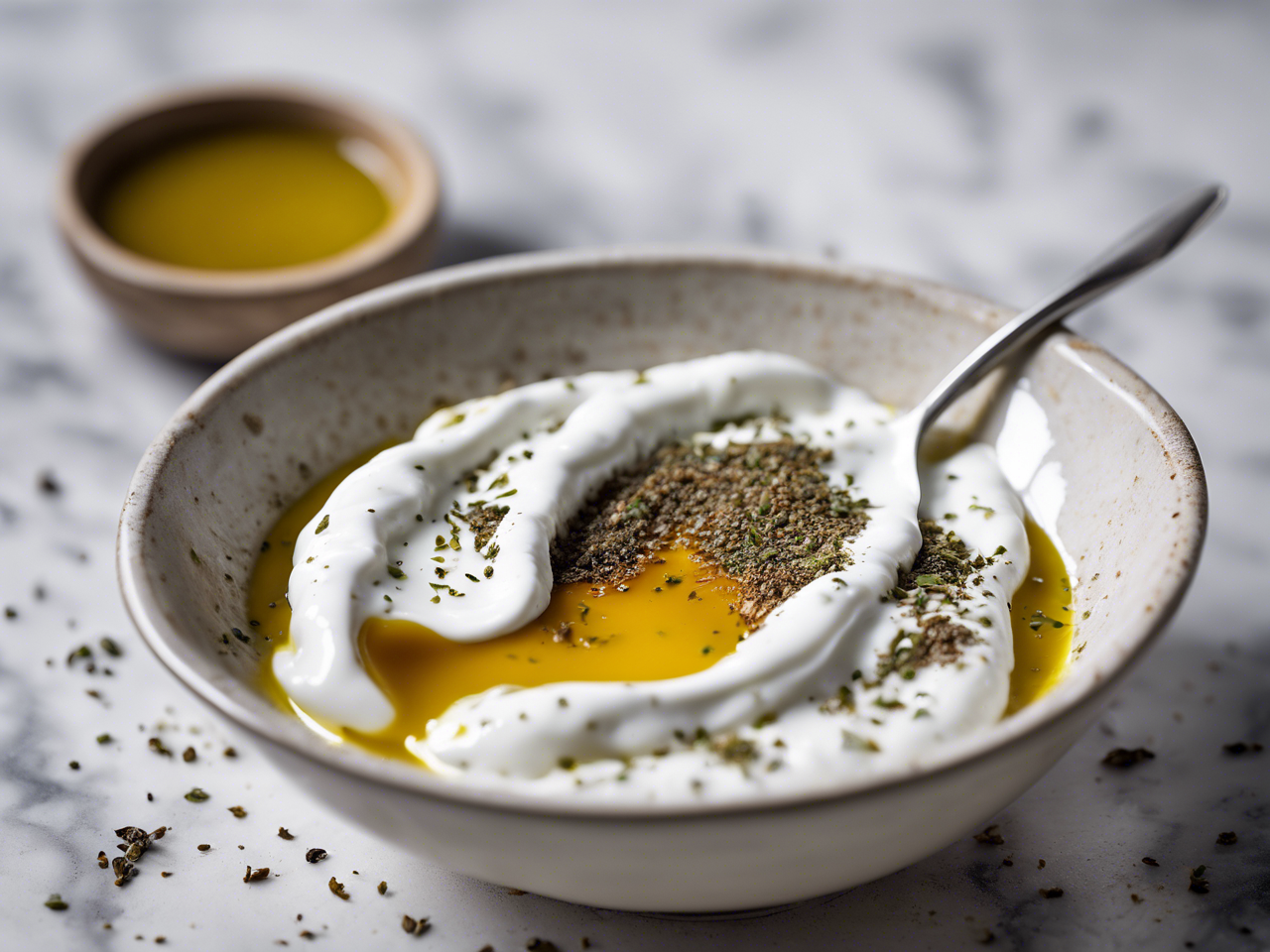Labneh
Discover the creamy, tangy delight of homemade Lebanese labneh—strained yogurt transformed into a luscious spread, topped with extra virgin olive oil and a fragrant sprinkle of za'atar spice. This easy-to-make recipe is your gateway to an authentic Middle Eastern treat that’s perfect for dipping, spreading, or savoring on its own.

If you like this tangy yogurt sauce, then you'll love this recipe: kibbeh in yogurt sauce.
Ingredients
Time
- Total:
- 10m
- Prep:
- 10m
- Extra:
- 24h resting time
- Plain unsweetened yogurt, 4 cups
- Salt, pinch
- Extra virgin olive oil, 2 tbsp
- Za'atar spice, 1 tbsp
Nutrition Facts
| Total Fat 5g | 8% |
| Saturated 1.6g | 8% |
| Omega-3 0g | 0% |
| Cholesterol 7.5g | 3% |
| Total Carbohydrates 7g | 2% |
| Dietary Fibers 1.3g | 4% |
| Sugars 6g | 7% |
| Protein 5.5g | 12% |
| Calcium 75mg | 8% |
| Vitamin A 21.3mg | 3% |
| Potassium 105mg | 3% |
| Sodium 62.5mg | 3% |
Instructions
Step 1
To create the perfect homemade Lebanese labneh, start with 2 cups of plain, unsweetened yogurt.
Choose a high-quality yogurt, as this will be the base of your labneh and greatly influence its flavor and texture.
Begin by lining a large sieve with a double layer of cheesecloth, ensuring the cloth extends over the edges.
Place the sieve over a deep bowl to catch the liquid that will drain from the yogurt. This liquid is whey: you can discard it or use it as a base for smoothies.
Step 2
Carefully spoon the yogurt into the center of the cheesecloth.
Once all the yogurt is in the sieve, gather the edges of the cheesecloth together and tie them securely with a string or twist tie, forming a bundle.
Suspend this bundle over the bowl by tying it to a wooden spoon or a similar utensil that can rest across the bowl's top.
This setup allows the yogurt to strain properly, removing excess moisture and thickening into a creamy spread.
Step 3
Place the bowl with the suspended yogurt bundle into the refrigerator and let it strain for at least 24 hours.
If you prefer a thicker consistency, resembling cream cheese, allow it to strain for up to 48 hours.
During this time, the whey will gradually drain out, leaving behind a rich, tangy labneh.
Step 4
After the straining period, remove the yogurt from the cheesecloth and transfer it to a mixing bowl.
Stir in a pinch of salt, adjusting to taste.
The salt enhances the labneh’s natural tanginess and brings out its creamy texture.
Step 5
To serve, spread the labneh into a shallow dish, creating a small well in the center with the back of a spoon.
Drizzle 2 tablespoons of extra virgin olive oil into the well and over the surface of the labneh.
Finally, sprinkle 1 tablespoon of za'atar spice evenly over the top, letting its earthy, tangy flavors complement the creamy yogurt.
Serve the labneh with warm pita bread, fresh vegetables, or as part of a mezze platter.
Goes well with
Perfect dip for pita bread or your favourite Levantine flatbread, like this Lebanese Pizza.
Also great as a drizzle to meat based dishes, like Shish Tawook, Kofta Kebabs, or all time classic Fatteh.
FAQ
How long does homemade labneh last?
Homemade labneh can last up to one week when stored in an airtight container in the refrigerator.
Can I use Greek yogurt to make labneh?
Yes, Greek yogurt works well and will produce a thicker labneh due to its lower water content.
What is za'atar spice, and where can I find it?
Za'atar is a Middle Eastern spice blend that typically includes thyme, sesame seeds, and sumac. It can be found in Middle Eastern grocery stores or online.
Is labneh the same as Greek yogurt?
While similar, labneh is yogurt that has been strained longer, resulting in a thicker, creamier texture and a slightly tangier taste.
Can I make labneh without cheesecloth?
Yes, you can use a clean kitchen towel or even a fine mesh strainer to achieve similar results.